The AMD Radeon R9 290X Review
by Ryan Smith on October 24, 2013 12:01 AM EST- Posted in
- GPUs
- AMD
- Radeon
- Hawaii
- Radeon 200
Bioshock Infinite
Bioshock Infinite is Irrational Games’ latest entry in the Bioshock franchise. Though it’s based on Unreal Engine 3 – making it our obligatory UE3 game – Irrational had added a number of effects that make the game rather GPU-intensive on its highest settings. As an added bonus it includes a built-in benchmark composed of several scenes, a rarity for UE3 engine games, so we can easily get a good representation of what Bioshock’s performance is like.
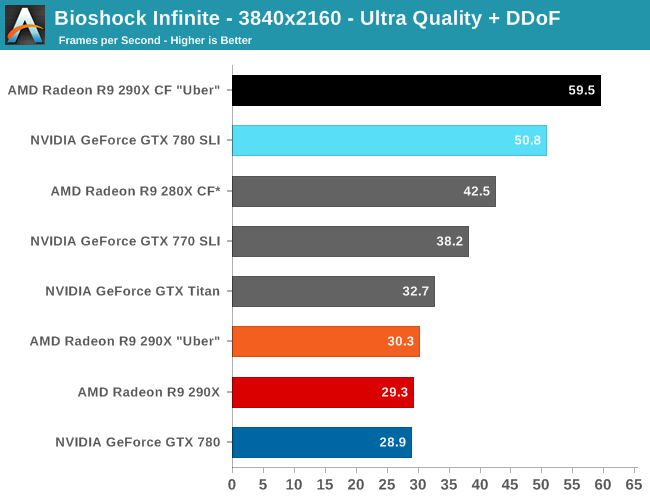

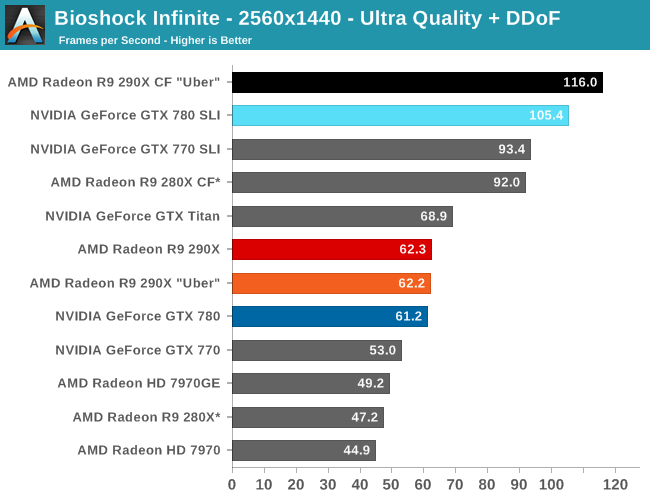
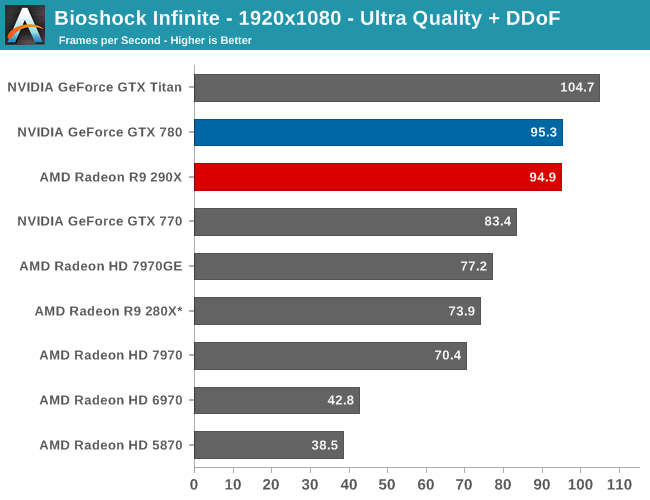
The first of the games AMD allowed us to publish results for, Bioshock is actually a straight up brawl between the 290X and the GTX 780 at 2560. The 290X’s performance advantage here is just 2%, much smaller than the earlier leads it enjoyed and essentially leaving the two cards tied, which also makes this one of the few games that 290X can’t match GTX Titan. At 2560 everything 290X/GTX 780 class or better can beat 60fps despite the heavy computational load of the depth of field effect, so for AMD 290X is the first single-GPU card from them that can pull this off.
Meanwhile at 4K things end up being rather split depending on the resolution we’re looking at. At Ultra quality the 290X and GTX 780 are again tied, but neither is above 30fps. Drop down to Medium quality however and we get framerates above 60fps again, while at the same time the 290X finally pulls away from the GTX 780, beating it by 14% and even edging out GTX Titan. Like so many games we’re looking at today the loss in quality cannot justify the higher resolution, in our opinion, but it presents another scenario where 290X demonstrates superior 4K performance.
For no-compromises 4K gaming we once again turn our gaze towards the 290X CF and GTX 780 SLI, which has AMD doing very well for themselves. While AMD and NVIDIA are nearly tied at the single GPU level – keep in mind we’re in uber mode for CF, so the uber 290X has a slight performance edge in single GPU mode – with multiple GPUs in play AMD sees better scaling from AFR and consequently better overall performance. At 95% the 290X achieves a nearly perfect scaling factor here, while the GTX 780 SLI achieves only 65%. Curiously this is better for AMD and worse for NVIDIA than the scaling factors we see at 2560, which are 86% and 72% respectively.
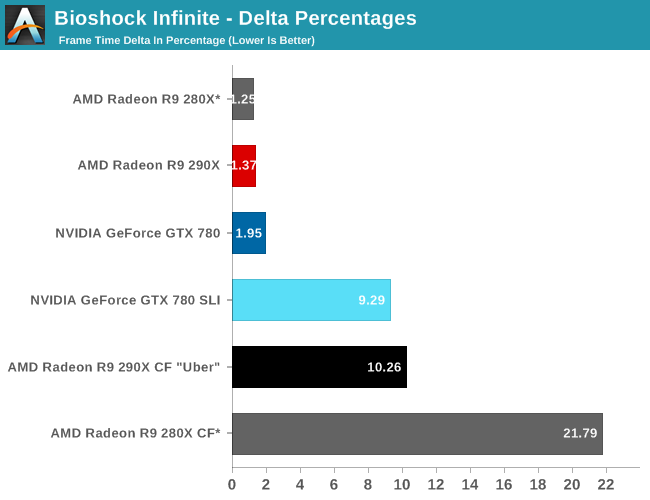

Moving on to our FCAT measurements, it’s interesting to see just how greatly improved the frame pacing is for the 290X versus the 280X, even with the frame pacing fixes in for the 280X. Whereas the 280X has deltas in excess of 21%, the 290X brings those deltas down to 10%, better than halving the variance in this game. Consequently the frame time consistency we’re seeing goes from being acceptable but measurably worse than NVIDIA’s consistency to essentially equal. In fact 10% is outright stunning for a multi-GPU setup, as we rarely achieve frame rates this consistent on those setups.
Finally for 4K gaming our variance increases a bit, but not immensely so. Despite the heavier rendering workload and greater demands on moving these large frames around, the delta percentages keep to 13%.


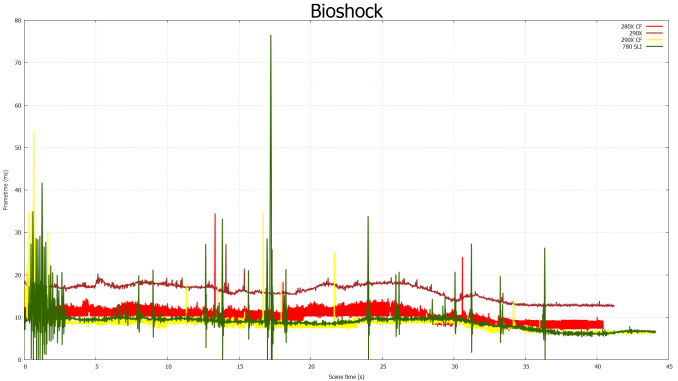









396 Comments
View All Comments
rituraj - Saturday, October 26, 2013 - link
So that "PROSUMER" cookie that nv tried to sell was just a grandma's cookie and it's proven now. I will buy the next maxwell flagship AND AT $600. (Lol.. I have to pay 20% more here in India)dazaj - Friday, October 25, 2013 - link
why is there no titan sli in all these benches but there is 290x cfRyan Smith - Friday, October 25, 2013 - link
Because we only have 1 Titan.just4U - Friday, October 25, 2013 - link
They likely didn't have two on hand..dazaj - Friday, October 25, 2013 - link
why is there no titan sli in any of these benchesdrinkperrier - Friday, October 25, 2013 - link
Just 1 question.Can i have the possibility to buy this videocard from AMD brand and not asus, sapphir and etc??
Ryan Smith - Friday, October 25, 2013 - link
Unfortunately no. AMD does not directly sell Radeon cards to consumers. They only directly sell Radeons to OEMs, while FirePros are directly sold to everyone.rituraj - Saturday, October 26, 2013 - link
The best thing I can get out of this release is that nVidia is not going to be able to charge $1000 for its next flagship or ultra-flagship. Because it's been proven that no matter what crazy performance it gives, it can be released at a 500-600 range by AMD and therefore by nVidia too. Even if they do, charge that much people will j7st wait for a few months for AMD to release an equally powerful card at 600 or 500. Good move AMD...SunLord - Saturday, October 26, 2013 - link
Saturday and I'm still not sure the reviews done or at least Anandtech has dropped making explaining and commenting on test resultspolaco - Saturday, October 26, 2013 - link
Origin PC will loose lots of possible sells by having dropped AMD. NVidia monopolistic friends pay the consequences...